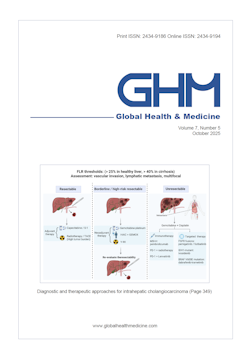Global Health & Medicine 2020;2(6):384-387.
Nucleos(t)ide reverse transcriptase inhibitor-sparing regimens in the era of standard 3-drug combination therapies for HIV-1 infection
Uchitsubo K, Masuda J, Akazawa T, Inoue R, Tsukada K, Gatanaga H, Terakado H, Oka S
Nucleos(t)ide reverse transcriptase inhibitor (NRTI)-sparing regimens have often been selected as antiretroviral therapy (ART) for HIV-1 infection recently, but data for characteristics have been lacking. This study aimed to document the current status of NRTI-sparing regimens in the era of standard 3-drug combination therapies. We cross-sectionally compared characteristics of patients treated with NRTI-sparing regimens (NRTI-sparing group) with dolutegravir plus tenofovir alafenamide fumarate/emtricitabine as a standard ART group in 2018. The NRTIsparing and the standard ART groups included 61 and 469 patients, respectively. The mean (± standard deviation) age and serum creatinine of the NRTI-sparing group were significantly higher than those of the standard ART group (57.6 ± 12.8 years vs 42.8 ± 10.4 years (p < 0.05) and 2.09 ± 3.10 mg/dL vs. 0.93 ± 0.19 mg/dL (p < 0.05), respectively. The percentage of patients with NRTI-sparing regimens increased with age; with less than 5% in their 50s or younger, 8.4% in their 60s, and 14.1% aged ≥ 70 years. The primary reason for switching to the NRTI-sparing regimen was due to reduced renal function. According to the limited data, viral suppression was achieved at week 48 in all patients in the NRTI-sparing group. No patient had treatment failure nor developed drug resistance. The use of NRTI-sparing regimens increased with age. They were more frequently used in patients aged ≥ 60 years and those with decreased renal function.
DOI: 10.35772/ghm.2020.01065







